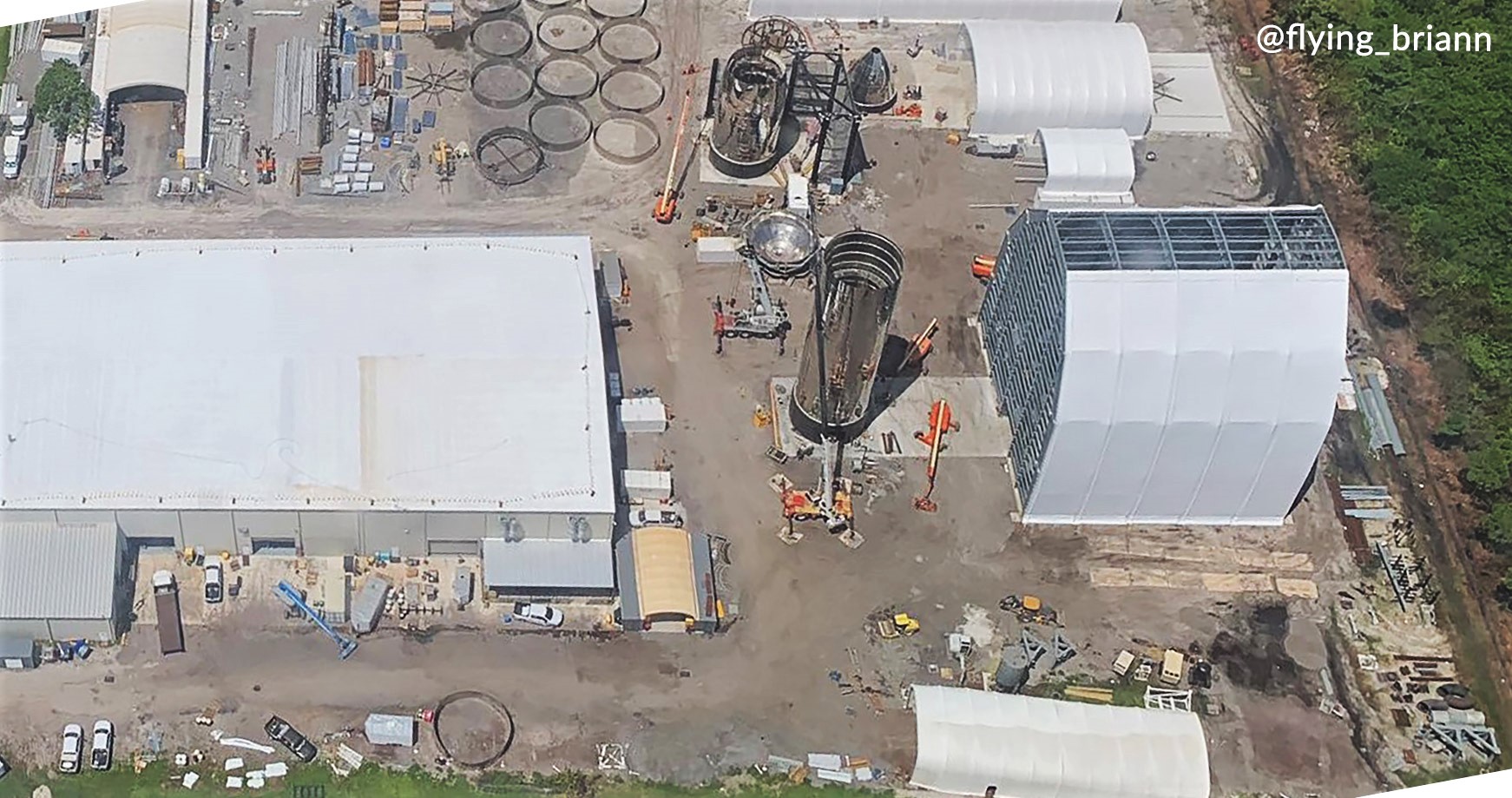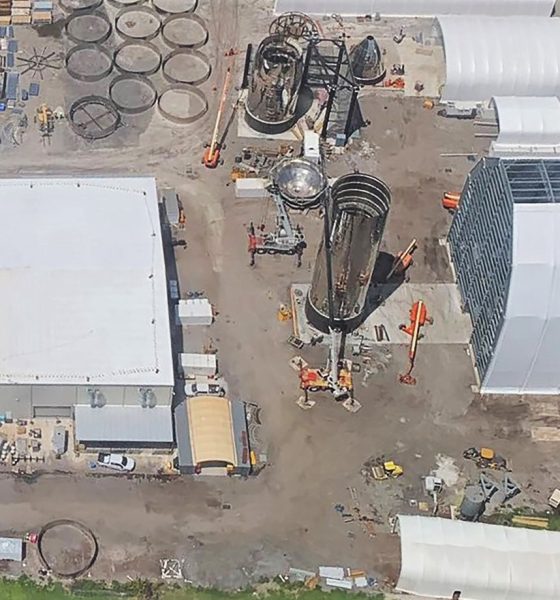

News
SpaceX wants to move Starship Mk2 to one of its Florida launch pads later this month
According to documents filed with local city and transportation authorities in recent months and cataloged by a few local news outlets and spaceflight fans, SpaceX is preparing to transport its East Coast Starship prototype – known as “Mk2” – as early as later this month.
Throughout August 2019, local resident, spaceflight fan, photographer, and cookie-baker Julia Bergeron did a significant amount of groundwork to flesh out an estimated route for Starship Mk2. Delivering the massive rocket prototype from Cocoa, Florida to SpaceX’s Kennedy Space Center Launch Complex 39A facilities would involve a 30+ mile trip by road, cost-prohibitive due to the amount of work required. Confirmed by documents unearthed by local ClickOrlando journalists, SpaceX will instead transport the rocket a few miles by road before loading it onto a barge and shipping the vehicle the rest of the way to KSC.
According to ClickOrlando’s report, those documents indicate that SpaceX will work with Roll-Lift – a familiar contractor for the company – to move Starship the few miles from its Cocoa, FL build site to a river access point located off of a nearby bridge. Once there, it will be loaded onto a barge on the Indian River and pass through the Canaveral Barge Canal to reach the Banana River. Once that leg is complete, it’s a fairly straight shot by barge to NASA’s Kennedy Space Center Turn Basin, historically used to deliver extra-large rocket components like Saturn V stages and Space Shuttle External Tanks.
After arriving at the Turn Basin, a few-mile trek along KSC’s Pad 39 Crawlerway will mark the last leg of the spaceship’s move to Pad 39A, where SpaceX broke ground just days ago on a concrete foundation that will eventually support a launch mount for Starship and Super Heavy.
Currently disassembled into a nose cone, upper nose, and tank section, it remains to be seen if SpaceX will transport Starship Mk2 in pieces or integrate the three segments before moving the giant rocket. Stretching 9m (30 ft) in diameter and 45-55m (150-180 ft) tall depending on the stage of assembly, Starship will likely weigh several dozen metric tons (100,000+ lb) and pose major challenges over such a long journey.
SpaceX and city workers have already spent the last two or so months either raising or burying a number of utility lines along the proposed transport route, a necessity to give a vertical Starship the headroom needed to traverse several miles of public roads.
After this move, it’s likely that SpaceX will move its Florida Starship factory to a new site inside the bounds of Kennedy Space Center. Currently known by the road it sits beside, SpaceX has already begun work on its prospective Roberts Road facilities. Proposed in 2018 as a convenient Falcon 9 refurbishment and launch control center (LCC), Roberts Road could also provide at least as much room for Starship production as is available at SpaceX’s current Cocoa, FL property while sidestepping the logistical headaches of transporting Starships – let alone Super Heavy boosters – dozens of miles.
SpaceX currently has more than two dozen stainless steel rings strewn about its Cocoa, FL build facilities, enough raw material to build more than 45m (150 ft) of the first Super Heavy booster or a Starship Mk3 prototype. Starship Mk2 has suffered some minor delays as a result of Hurricane Dorian but is poised to be capped with its third and final propellant tank dome before the end of the month. Starship Mk1 (located in Boca Chica, TX) and Starship Mk2 remain more or less neck-and-neck as the distinct SpaceX teams compete to complete their prototypes first.
According to ClickOrlando’s documentation, SpaceX plans to move Starship Mk2 to Pad 39A as early as this month. The on-road leg will take place at night and require road and highway closures, while SpaceX estimates that the entire transportation process could take up to two weeks from start to finish.
Check out Teslarati’s Marketplace! We offer Tesla accessories, including for the Tesla Cybertruck and Tesla Model 3.

News
Tesla FSD fleet is nearing 7 billion total miles, including 2.5 billion city miles
As can be seen on Tesla’s official FSD webpage, vehicles equipped with the system have now navigated over 6.99 billion miles.

Tesla’s Full Self-Driving (Supervised) fleet is closing in on almost 7 billion total miles driven, as per data posted by the company on its official FSD webpage.
These figures hint at the massive scale of data fueling Tesla’s rapid FSD improvements, which have been quite notable as of late.
FSD mileage milestones
As can be seen on Tesla’s official FSD webpage, vehicles equipped with the system have now navigated over 6.99 billion miles. Tesla owner and avid FSD tester Whole Mars Catalog also shared a screenshot indicating that from the nearly 7 billion miles traveled by the FSD fleet, more than 2.5 billion miles were driven inside cities.
City miles are particularly valuable for complex urban scenarios like unprotected turns, pedestrian interactions, and traffic lights. This is also the difference-maker for FSD, as only complex solutions, such as Waymo’s self-driving taxis, operate similarly on inner-city streets. And even then, incidents such as the San Francisco blackouts have proven challenging for sensor-rich vehicles like Waymos.
Tesla’s data edge
Tesla has a number of advantages in the autonomous vehicle sector, one of which is the size of its fleet and the number of vehicles training FSD on real-world roads. Tesla’s nearly 7 billion FSD miles then allow the company to roll out updates that make its vehicles behave like they are being driven by experienced drivers, even if they are operating on their own.
So notable are Tesla’s improvements to FSD that NVIDIA Director of Robotics Jim Fan, after experiencing FSD v14, noted that the system is the first AI that passes what he described as a “Physical Turing Test.”
“Despite knowing exactly how robot learning works, I still find it magical watching the steering wheel turn by itself. First it feels surreal, next it becomes routine. Then, like the smartphone, taking it away actively hurts. This is how humanity gets rewired and glued to god-like technologies,” Fan wrote in a post on X.
News
Tesla starts showing how FSD will change lives in Europe
Local officials tested the system on narrow country roads and were impressed by FSD’s smooth, human-like driving, with some calling the service a game-changer for everyday life in areas that are far from urban centers.

Tesla has launched Europe’s first public shuttle service using Full Self-Driving (Supervised) in the rural Eifelkreis Bitburg-Prüm region of Germany, demonstrating how the technology can restore independence and mobility for people who struggle with limited transport options.
Local officials tested the system on narrow country roads and were impressed by FSD’s smooth, human-like driving, with some calling the service a game-changer for everyday life in areas that are far from urban centers.
Officials see real impact on rural residents
Arzfeld Mayor Johannes Kuhl and District Administrator Andreas Kruppert personally tested the Tesla shuttle service. This allowed them to see just how well FSD navigated winding lanes and rural roads confidently. Kruppert said, “Autonomous driving sounds like science fiction to many, but we simply see here that it works totally well in rural regions too.” Kuhl, for his part, also noted that FSD “feels like a very experienced driver.”
The pilot complements the area’s “Citizen Bus” program, which provides on-demand rides for elderly residents who can no longer drive themselves. Tesla Europe shared a video of a demonstration of the service, highlighting how FSD gives people their freedom back, even in places where public transport is not as prevalent.
What the Ministry for Economic Affairs and Transport says
Rhineland-Palatinate’s Minister Daniela Schmitt supported the project, praising the collaboration that made this “first of its kind in Europe” possible. As per the ministry, the rural rollout for the service shows FSD’s potential beyond major cities, and it delivers tangible benefits like grocery runs, doctor visits, and social connections for isolated residents.
“Reliable and flexible mobility is especially vital in rural areas. With the launch of a shuttle service using self-driving vehicles (FSD supervised) by Tesla in the Eifelkreis Bitburg-Prüm, an innovative pilot project is now getting underway that complements local community bus services. It is the first project of its kind in Europe.
“The result is a real gain for rural mobility: greater accessibility, more flexibility and tangible benefits for everyday life. A strong signal for innovation, cooperation and future-oriented mobility beyond urban centers,” the ministry wrote in a LinkedIn post.
News
Tesla China quietly posts Robotaxi-related job listing
Tesla China is currently seeking a Low Voltage Electrical Engineer to work on circuit board design for the company’s autonomous vehicles.

Tesla has posted a new job listing in Shanghai explicitly tied to its Robotaxi program, fueling speculation that the company is preparing to launch its dedicated autonomous ride-hailing service in China.
As noted in the listing, Tesla China is currently seeking a Low Voltage Electrical Engineer to work on circuit board design for the company’s autonomous vehicles.
Robotaxi-specific role
The listing, which was shared on social media platform X by industry watcher @tslaming, suggested that Tesla China is looking to fill the role urgently. The job listing itself specifically mentions that the person hired for the role will be working on the Low Voltage Hardware team, which would design the circuit boards that would serve as the nervous system of the Robotaxi.
Key tasks for the role, as indicated in the job listing, include collaboration with PCB layout, firmware, mechanical, program management, and validation teams, among other responsibilities. The role is based in Shanghai.
China Robotaxi launch
China represents a massive potential market for robotaxis, with its dense urban centers and supportive policies in select cities. Tesla has limited permission to roll out FSD in the country, though despite this, its vehicles have been hailed as among the best in the market when it comes to autonomous features. So far, at least, it appears that China supports Tesla’s FSD and Robotaxi rollout.
This was hinted at in November, when Tesla brought the Cybercab to the 8th China International Import Expo (CIIE) in Shanghai, marking the first time that the autonomous two-seater was brought to the Asia-Pacific region. The vehicle, despite not having a release date in China, received a significant amount of interest among the event’s attendees.








